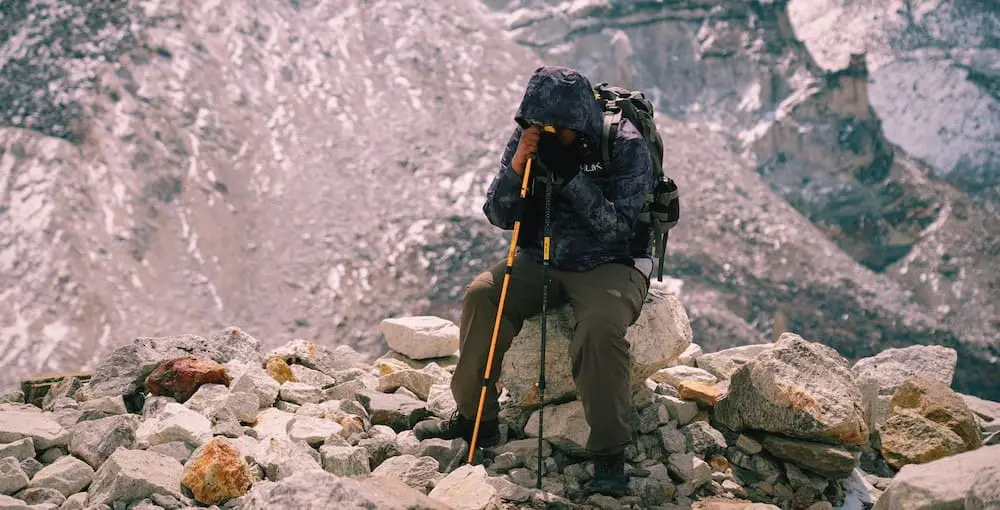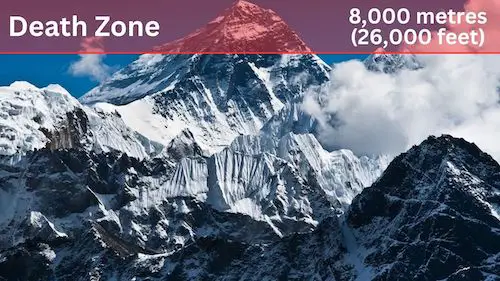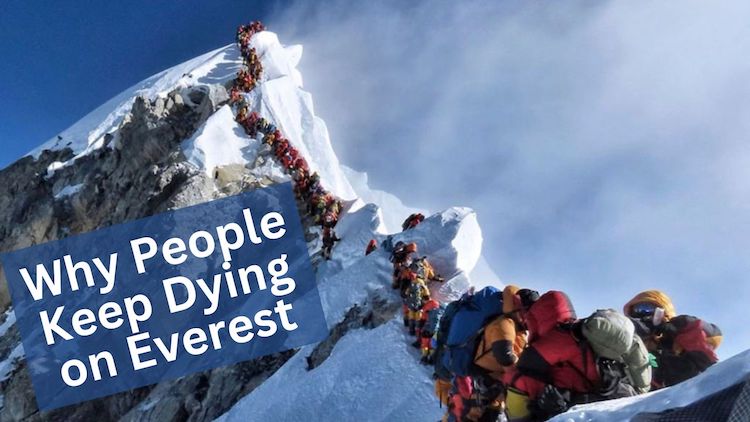Since the first successful ascent in 1953, Mount Everest has become a sought-after destination for climbers and adventurers from all over the world. However, with this dream comes significant dangers and risks, and many people have lost their lives while climbing the Mountain. So why do people keep dying on Mount Everest then?
This is a question that has sparked much debate in the mountaineering sphere. With the improvement in modern equipment the mountain has become more accessible as well as increasingly commercialized. This has meant more and more people attempting to climb the tallest mountain in the world. Unfortunately, not everyone who sets out to conquer Everest returns home.
Today we explore why people keep dying on Mount Everest. Including the role of altitude sickness, weather conditions, human error, and overcrowding. We also look at the death zone on Everest, the problem of bodies on the mountain, and the efforts to reduce fatalities.
Why Do People Keep Dying on Mount Everest?
The main reason why people keep dying on Everest are exhaustion and injuries. However, a significant number of climbers also pass away due to altitude-related illnesses, notably high altitude cerebral edema (HACE) and high altitude pulmonary edema (HAPE).
Factors Contributing To Deaths On Mount Everest
The most common factors leading to death on Everest are high altitude sickness, exhaustion, frostbite, falls, avalanches, rockfalls, and cracks.
Currently there are around 300 dead bodies on Everest, with more and more people loosing their lives on the mountain, and specifically in the Rainbow Valley of Everest. However, it is head scratching at times for why people continue to parish on the mountain as significant improvements in equipment and training have continued over recent years.
Below we go through some of the leading factors contributing to deaths on Everest.
1. Altitude Sickness

Altitude sickness is a significant risk and one of the leading causes to death for climbers attempting to summit the mountain. The air pressure and oxygen levels are much lower at high altitudes, making it more challenging for the human body to function correctly. Altitude sickness can cause symptoms from mild headaches and nausea to more severe conditions like pulmonary and cerebral edema.
Cerebral edema is potentially life-threatening when the brain swells due to the lack of oxygen at high altitudes. On the other hand, pulmonary edema is a condition where fluid builds up in the lungs, making it difficult for the body to get enough oxygen.
Both of these conditions can lead to death if not treated promptly. Unfortunately, there is no guaranteed way to prevent altitude sickness, but climbers can take steps to minimize their risk. One strategy is to acclimatize gradually, spending time at lower altitudes to allow the body to adjust to the lower oxygen levels. Climbers can also take medication to prevent or treat altitude sickness, such as acetazolamide or dexamethasone.
2. Weather Conditions and Human Error
Mount Everest is known for its extreme weather conditions, which can change rapidly and unpredictably. Storms, high winds, and sub-zero temperatures are all common on the Mountain, making it a challenging environment for climbers to navigate. In 1996, a massive storm struck Mount Everest, causing the deaths of eight climbers in a single day and inspiring the book and movie “Into Thin Air” by Jon Krakauer. The day eventually became one of the deadliest events in Everest’s history, and is now known as the 1996 Mount Everest Disaster.
Like any dangerous activity, climbing Mount Everest carries the risk of human error. Mistakes made by climbers or their support teams can have dire consequences on the Mountain. For example, a misplaced rope, faulty equipment, or miscommunication can all lead to serious accidents. In some cases, climbers may make poor decisions due to fatigue, lack of oxygen, or other factors that can impair judgment.
3. Avalanches
Avalanches are a significant risk factor for climbers attempting to summit Mount Everest. Due to the Mountain’s extreme weather conditions, avalanches can occur suddenly and without warning. Climbers can be caught off guard, unable to escape the path of the avalanche. The fast-moving snow and debris can sweep climbers off their feet and carry them down the Mountain.
In 2014, a devastating avalanche killed 16 Sherpas working on setting up ropes and ladders for climbers. This tragedy highlighted the dangers of avalanches on the Mountain and the risks faced by those who support climbers’ attempts to summit Mount Everest. While climbers cannot control the weather, they can take steps to minimize their risk of being caught in an avalanche. This includes avoiding high-risk areas and monitoring weather conditions closely.
4. Overcrowding
In recent years, overcrowding has become a significant problem on Mount Everest. With more and more climbers attempting to summit the Mountain each year, the number of people climbing it has skyrocketed. In 2019, a photo of a long line of climbers waiting to reach the summit of Mount Everest went viral. It highlights the dangerous conditions that can arise when too many people are on the mountain at once. (Image can be seen at the top of the blog.)
The Death Zone and Bodies on Mount Everest

The “death zone” refers to the altitude above 8,000 meters on Mount Everest, where the air pressure and oxygen levels are so low that human life cannot be sustained for more than a few days. Climbers who enter the death zone face a significant risk of altitude sickness, frostbite (accounting for around 11% of fatalities), and other life-threatening conditions.
The problem of bodies on Mount Everest is a grim reality of climbing the Mountain. Due to the extreme conditions in the death zone, it is often extremely difficult to recover the bodies of climbers who have died on the Mountain. As a result, the bodies of deceased climbers such as Green Boots, remain on Mount Everest for years or even decades, serving as a sobering reminder of the risks associated with climbing the world’s highest peak.
Efforts to Reduce Deaths on Mount Everest
In recent years, efforts have been made to reduce the number of deaths on Mount Everest. The Nepalese government has implemented new regulations, such as limiting the number of climbers and requiring climbers to have a minimum level of experience and training.
There have also been technological advancements, such as better weather forecasting and advanced equipment, which can help climbers prepare and stay safe on the Mountain. Ethical considerations have also been raised, with many people arguing that climbers and climbing companies are responsible for respecting the Mountain and its environment – not only in terms of deaths, but also with the growing Mount Everest trash problem.
Key takeaways: Why People Keep Dying on Everest
While Everest remains a unique and popular destination for climbers, one should still be weary while climbing. Altitude sickness, weather conditions, avalanches, and human error are all significant causes of deaths.
The death zone and the bodies scattered amongst it, are a stark reminder of the dangers of climbing the mountain. Only through a combination of regulation, technology, and ethical considerations can we hope to reduce the number of deaths on Mount Everest and make it a safer place for climbers.
Want to learn more about Everest? Then check out Tim Macartney-Snape and his team’s daring 1984 Australian Expedition!
FAQs: Why Do People Keep Dying on Mount Everest
Below are some of the most frequently asked questions regarding why so many people succumb to death on Everest.
The most common reason for people dying on Everest include high altitude sickness, exhaustion, frostbite, falls, avalanches, and rockfalls. Out of the almost 300 deaths, a third of them have succumbed to lack of oxygen.
The decrease in air pressure results in the air density to be thiner. Meaning that the amount of oxygen in the air is reduced making it harder to get oxygen. At the summit of Mount Everest, the available oxygen is only one-third of that at sea level.
Over the past three decades, the fatality rate for climbing Mount Everest has averaged around 1%. Additionally, the ratio of deaths to successful attempts is roughly 4%. Therefore, the likelihood of dying during the climb is relatively low. Provided that you are suitably prepared and accompanied by a qualified guide.

Just a small correction: in that fateful night 11 people died on Everest. 3 climbers of the Indo-Tibetan Border Police died on the North side, 8 on the South side.
Otherwise an interesting article!
The eight total deaths include the 3 climbers of the Indo-Tibetan Border Police! We will go back and double check though! We appreciate the love and support [:
Please ignore my previous comment. Death toll in the disaster night was 8 (Fischer, Hall, Hansen, Morup, Paljor, Smanla, Namba, Harris). Looked it up, should have done this before posting a comment, sorry.
No worries! We are always learning something new! Appreciate you clarifying this for everyone though [: